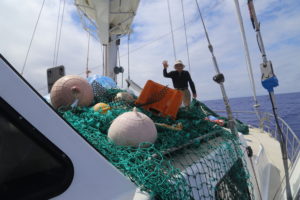Check out all 2016/2017 South Pacific Expedition Blogs here.
By 1700 yesterday evening our Manta Trawl samples were diminishing in micro-plastic (≤5mm) quantities and our macro -debris collection (≥20mm) was nil. A positive sign!? Well, yes in some ways! It is telling us that we were moving along the edge of the accumulation zone rather than into it. We dropped our sails and altered our course to begin to head south east to where we could observe a larger high pressure system on our radar, signs a calm region where plastic may be accumulating.
Within half an hour of changing our course we spotted our first item of macro debris, a 30cm long white HDPE (High Density Polyethylene) plastic casing, with bite marks in it! We are on the right track. Looking at the bite marks, some big teeth have chomped into this one!
 The next half hour bought along a ghost net, quite a hefty bundle of loose net floating aimlessly through the ocean, collecting whatever unsuspecting thing or creature gets in its way. Due to this one’s minimal organic fouling and collection Captain Moore predicts it can’t have been adrift for longer than 3 months. There were several juvenile and small fish species that were hanging around it, some of which are common coastal species to the region. It’s a sign that the net came from a far off coast, even though we found it over 300 nautical miles from land and in waters over 2 miles deep. This kind of debris not only destructively captures and kills marine life, but also alters the ecosystem by providing an artificial habitat.
The next half hour bought along a ghost net, quite a hefty bundle of loose net floating aimlessly through the ocean, collecting whatever unsuspecting thing or creature gets in its way. Due to this one’s minimal organic fouling and collection Captain Moore predicts it can’t have been adrift for longer than 3 months. There were several juvenile and small fish species that were hanging around it, some of which are common coastal species to the region. It’s a sign that the net came from a far off coast, even though we found it over 300 nautical miles from land and in waters over 2 miles deep. This kind of debris not only destructively captures and kills marine life, but also alters the ecosystem by providing an artificial habitat.
We hauled the net aboard and tried to free as many of the small crabs as possible. We will take it with us to Chile where we hope to deliver it to one of the fishing net re-purposing initiatives they have there, such as Bureo Sunglasses and Skateboards. In the meantime, it is sitting up on the top deck along with the rest of our debris that we collect. As you can see in the picture, we’ve collected a lot of macrodebris, but it’s not as easy as it sounds! The person who spots the item calls out, and keeps their eye on the piece as it’s easy to lose track. The crew member navigating slows the boat down (by hauling in a sail, turning into the wind or slowing the motors) and we take a detour to retrieve it. If it is a large piece, we’ll jump in and dive around it to film it and see what we can get for dinner, before hauling it aboard. I am often grateful for the electronic winch and large gantry arm off our stern when it comes to hauling these objects out.

